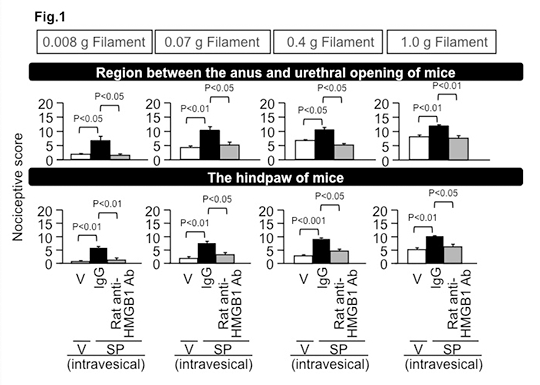Print version
Search Pub Med
Involvement of high mobility group box 1 in substance P-induced cystitis-related bladder pain in mice High mobility group box 1 (HMGB1), a nuclear protein, is released from damaged cells and/or secreted by certain cells during inflammation. HMGB1 is now considered to participate in processing of inflammatory somatic (1) or bladder pain (2), in addition to the development of inflammation. Given the evidence that substance P (SP), a neurotransmitter, is involved in the pathology of interstitial cystitis characterized by severe bladder pain, in the present study, we created a SP-induced cystitis-related bladder pain model in mice and determined possible involvement of HMGB1. Adult female ddY mice (n=5−6) received intravesical injection of SP at 6 nmol/mouse (200 μL of 30 μM solution, for 30 min) twice. Referred hyperalgesia was evaluated by scoring the nociceptive responses to mechanical stimulation applied to the skin region between the anus and urethral opening, or the hindpaw, 24 h after SP treatment, using von Frey filaments. The tissue weight of isolated bladder was determined as an indicator of edema. The anti-HMGB1 neutralizing antibody (anti-HMGB1 Ab) at 1 mg/kg or the control IgG at 1 mg/kg was administered i.p. 23 h after SP. Intravesical SP caused referred hyperalgesia accompanying increased bladder weight. Post-treatment with anti-HMGB1 Ab significantly suppressed the SP-induced referred hyperalgesia (Fig. 1).
Fig.1 Effect of post-administration of the anti-HMGB1 Ab on SP-induced referred hyperalgesia accompanying cystitis in mice. V, vehicle; SP, substance P. Statistics analysis: Data are represented as means with SEM. Statistical significance for parametric data was analyzed by Student’s t-test for comparison between two groups and by analysis of variance followed by Tukey’s test for multiple comparisons. For nonparametric analysis, Wilcoxon t-test was used for comparison between two groups, and Kruskal-Wallis H test followed by a least significant difference-type test was employed for multiple comparisons. Significance was set at a level of P < 0.05. In summary, neutralization of HMGB1 reversed the referred hyperalgesia following SP-induced cystitis. These data suggest that endogenously released HMGB1 contributes to SP-induced bladder pain and could serve as a therapeutic target for treatment of bladder pain accompanying interstitial cystitis. (1) Tanaka J, et al. (2014) Br J Pharmacol 170: 1233-1241. (2) Tanaka J, et al. (2014) Neuropharmacology 79:112-180.
|


